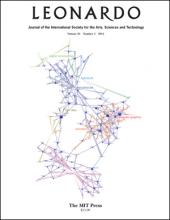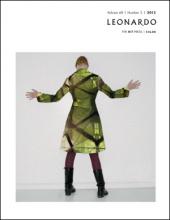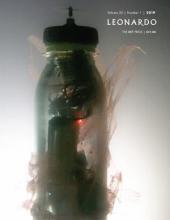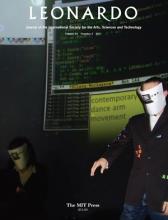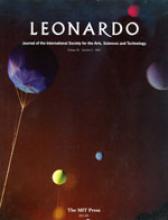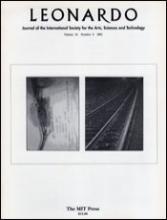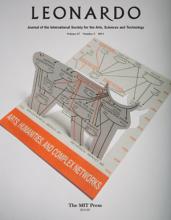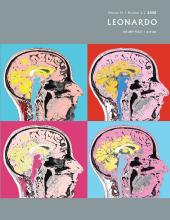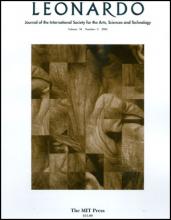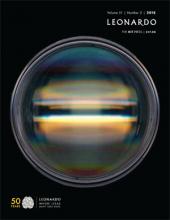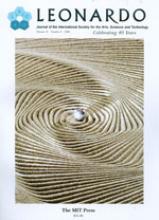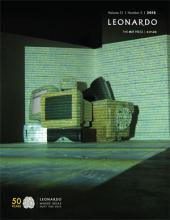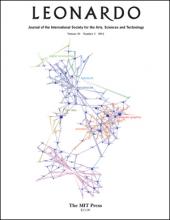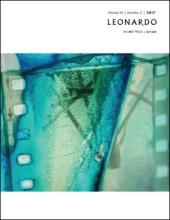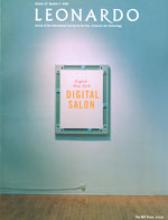
Research and Reading on Art, Viruses and Social Connectedness
We’ve curated a reading list for you. These are free for everyone to read for the time being. Please use these for your own reading, as curriculum or for research.
Anker, Suzanne. “Gene Culture: Molecular Metaphor in Visual Art,” Leonardo 33, No. 5, 371–375 (2000).
This paper addresses visual art's relationship to genetics and its attendant metaphorical representation. By diagramming models of the ways in which DNA is visualized and comprehended as a system of signs, parallel conceptions between art history's engagement with abstraction, recontextualization, and duplication is compared to genetic process and laboratory experimentation. Read more
Barker, Timothy S. “Becoming Organ-ized: The Creativity of Organization, Dis-Organization and Re-Organization in Scientific and Artistic Experiments,” Leonardo 45, No. 3, 262–268 (2012).Taking its starting point from a recent experiment in the genetics of E. coli, this article explores how processes of organization, dis-organization and re-organization may be thought of as creative. Extending Deleuze and Guattari's concept of the Body without Organs and citing artworks such as George Legrady's Slippery Traces, Paul DeMarinis's Messenger, Jon McCormack's Eden and Natalie Jeremijenko's One Trees, the paper juxtaposes recent scientific research with experimental art in order to reformulate the concept of organization for use in artistic and interactive settings, theorizing it as a creative process rather than positioning it as a limiting, institutionalizing or negative force. Read more
Bakke, Monika. “Living (on) Dust: Around the Globe with Mineral Particles & Microbial Hitchhikers,” Leonardo 48, No. 3, 266–267 (2015).Moving dust is full of life, but this life is not what makes it move. Since the establishment of the germ theory of disease, dust has mainly been viewed as being invisibly threatening and visibly distressful. In this article, the author emphasizes that there has been another view on dust all along: This view both links the presence of dust in the atmosphere to meteorological events crucial for life and acknowledges its vital impact on the global ecology of land, water and air in a deep-time perspective. Moving dust is a planetary force of inseparable organic and nonorganic matter that shelters, transports, feeds but also kills life. Recently the force of dust, which has yet to be fully comprehended, has been employed in controversial geoengineering practices. Read more
Dumitriu, Anna; and Goldberg, Sarah. “Make Do and Mend: Exploring Gene Regulation and CRISPR through a FEAT (Future Emerging Art and Technology) Residency with the MRG-Grammar Project,” Leonardo 52, No. 1, 66–67 (2019).This article documents the artistic research the author undertook for FEAT (Future Emerging Art and Technology) residency. It describes her collaboration with the MRG-Grammar consortium and the creation of an artwork that involved editing the genome of a bacterium using CRISPR to reflect on issues related to antimicrobial resistance, biohacking and control. The article explores the author’s methodology and describes the benefits of long-term embedded residencies to create artworks that are deeply engaged with emerging technologies with a view to enable the public to access the concepts and implications of cutting-edge technologies and scientific research through an artistic lens. Read more
Dumitriu, Anna; and Whitby, Blay. “Cybernetic Bacteria 2.0,” Leonardo 44, No. 3, 264–265 (2011).The transdisciplinary art project Cybernetic Bacteria 2.0 brings together an artist, a philosopher, a microbiologist, an artificial life programmer and an interactive media specialist, to investigate the relationship of the emerging science of bacterial communication to our own digital communications networks, looking in particular at ‘packet data’ and bacterial quorum sensing. The project seeks to reflect the complexity of communication taking place at a microscopic level in comparison with human communication technologies such as the Internet. Read more
Kunst, Bojana. “Liberation or Control: Disobedient Connections in Contemporary Works,” Leonardo 38, No. 5, 419–423 (2005).The concept of connection has assumed a very ambivalent status today. Being connected exposes the liberating potential of connected public participation, which has changed our understanding of political and intimate life. At the same time there is a strong fear at work that this very potential could result in a more rigid form of contemporary life. Connection, as understood in this article, is something procedural that can at the same time be disobedient to its own procedure. This disobedience can be concretely observed in certain contemporary artistic works, for example in the project ωPack from Intima Virtual Base. Read more
Levy, Ellen K. “The Genome and Art: Finding Potential in Unlikely Places,” Leonardo 34, No. 2, 172–175 (2001).Endnote. Genomics is rapidly developing into a commercial enterprise. Much of our genetic code, however, consists of seemingly valueless sections referred to as “junk,” such as Alu sequences and repetitive phrases, which do not participate in the production of proteins. What could be the purpose of the great number of redundant elements interlaced within the otherwise information-rich framework of DNA? Read more
McCluer, Forrest. “Computer Virus Sculptures and the Science That Inspired Them,” Leonardo 47, No. 3, 206–212 (2014).This article explores the remarkable shape and structure of biological viruses through the lens of sculptures composed of parts from discarded computers. The science that inspired these sculptures is briefly reviewed. Collectively, these artworks are called the Computer Virus Sculpture series. Read more
Nikolic, Predrag; and Cheok, Adrian David. “InnerBody: Using Interactive and Multisensory Interfaces to Design Behavioral Change,” Leonardo 53, No. 2, 128–134 (Forthcoming April 2020).
The authors propose using interactive and multisensory interfaces to design user behavior change. For this purpose, they used coauthor Nikolic's interactive art installation InnerBody, created to provoke health-care-related behavioral changes by arousing death anxiety. Visitors are invited to undertake a (fake) medical examination by interacting with the installation's human heart-shaped interface. Research outcomes are presented based on visitors' observations and participant responses in interviews after interacting with the installation. Read more
O’Brien, Martin. “Flesh-eaters: Notes toward a Zombie Methodology,” Leonardo 49, No. 3, 264–265 (2016).This article reflects upon Martin O’Brien’s 2015 commission Taste of Flesh/Bite Me I’m Yours as part of Trust Me, I’m an Artist, a Creative Europe-funded project. O’Brien discusses the ethics of witnessing the “sick body” in performance and considers the concept of disease as a mode of spectatorship—a concept employed in order to think through the politics of witnessing difficult performance work by artists with illnesses. The artist particularly reflects upon the nature of participation during his performance, which involved explicit interaction with his body as “sick.” O’Brien concludes by considering the ways in which the nature of this interaction allows for the striving toward agency over one’s own flesh. Read more
Rackham, Melinda. “Carrier: Forever Bound,” Leonardo 36, No. 2, 103–104 (2003).Carrier crosses a dangerous and sacred boundary into the domain of dynamically gendered cross-species relationships. The Carrier web site examines viral infection by weaving an intimate, almost erotic, relationship between the viewer and the virus, which is the Hepatitis C virus (HCV). Read more
This paper describes a transdisciplinary approach that takes places in South of Brazil with the aim to contribute with an eco-bio-social problem: dengue fever. Inspired by enactive theories about relation between body x environment, the authors present here a nontraditional multifaceted bottom-up intervention, designed by civic-oriented journalists and artists to promote health and mobilize a small community in Maringá. The intention is to promote healthier behavior in a participatory perspective when citizens can produce and share their narratives. The content was used as creative material to produce multimedia news, sketch and prototype mobile apps with the support of community. Read more
Salk, Jonas. “The Next Evolutionary Step in the Ascent of Man in the Cosmos,” Leonardo 18, No. 4, 1985 (reprinted Leonardo 41, No. 3, 2008).Physician-scientist Jonas Salk comments on the concerns about humanity's future and the values he shared with Jacob Bronowski. The author outlines his own view of evolution and acknowledges Bronowski's contributions to our further understanding of this process in which humans are participants as well as products. Like Bronowski, the author believes the human race has the power to influence its future, whether by creating disaster or by saving itself through conscious choice. He envisions as the next evolutionary step the creative interaction and convergence of the various cultures, including the ‘two cultures’ of science and humanism examined by Bronowski. The author suggest that our ‘evolutionary instinct’ will guide us in this direction, and he challenges us to prepare for a future without catastrophe. Read more
Spiess, Klaus; Strecker, Lucie; Kimmel, Michael; Martes, Melanie; and Pietschmann, Peter. “Modeling the Immune System with Gestures: A Choreographic View of Embodiment in Science,” Leonardo 51, No. 5, 509–516 (2018).The authors describe a cross-disciplinary collaboration in which they apply both a qualitative/quantitative and a choreographic analysis to the gestures immunologists use when lecturing on immunity. They identify particular spatiotemporal features by which immunologists have mapped, embodied and blended the conceptual spaces of the molecular and cellular. The immunologists’ difficulties in integrating the differing spatiotemporal modes of observing and embodying revealed hidden policies in their concepts of immunity. The variety of modes, blending and cinematic techniques applied invite a closer cross-disciplinary look at the vivid visual scenario of gesturing in science and consideration of its potential for creating corporeal models of art and science. Read more
Van den Broeck, Wouter; Quaggiotto, Marco; Isella, Lorenzo; Barrat, Alain; and Cattuto, Ciro. “The Making of Sixty-Nine Days of Close Encounters at the Science Gallery,” Leonardo 45, No. 3, 285–285 (2012).The SocioPatterns sensing platform uses wearable electronic badges to sense close-range proximity among individuals. It was used in an experiential exhibit that simulated a virtual epidemic among the visitors of the INFECTIOUS: STAY AWAY exhibition in the Science Gallery in Dublin, Ireland. The collected data was used to generate a high-resolution visualization that illustrates the variation in contact activity over the course of the exhibition. Read more
Van der Meulen, Sjoukje. “A Strong Couple: New Media and Socially Engaged Art,” Leonardo 50, No. 2, 170–176 (2017).Despite the relevance of new media art for the critical understanding of the information and network societies today, it is largely ignored as a socially engaged practice—certainly compared to other forms of socially engaged artistic practices in the international field of contemporary art. This article outlines the reasons for this relative neglect and specifies different kinds of new media art that qualify for the category of socially engaged art beyond leftist politics and ideologies transposed to the realm of art. Proposing and mobilizing a “media-reflexive” art theory, which emerged from the author’s doctoral dissertation, this claim is substantiated by the analysis of three exemplary digital art projects by Joseph Nechvatal, George Legrady and Blast Theory, respectively. Read more
Subscribe to Leonardo journal here.

